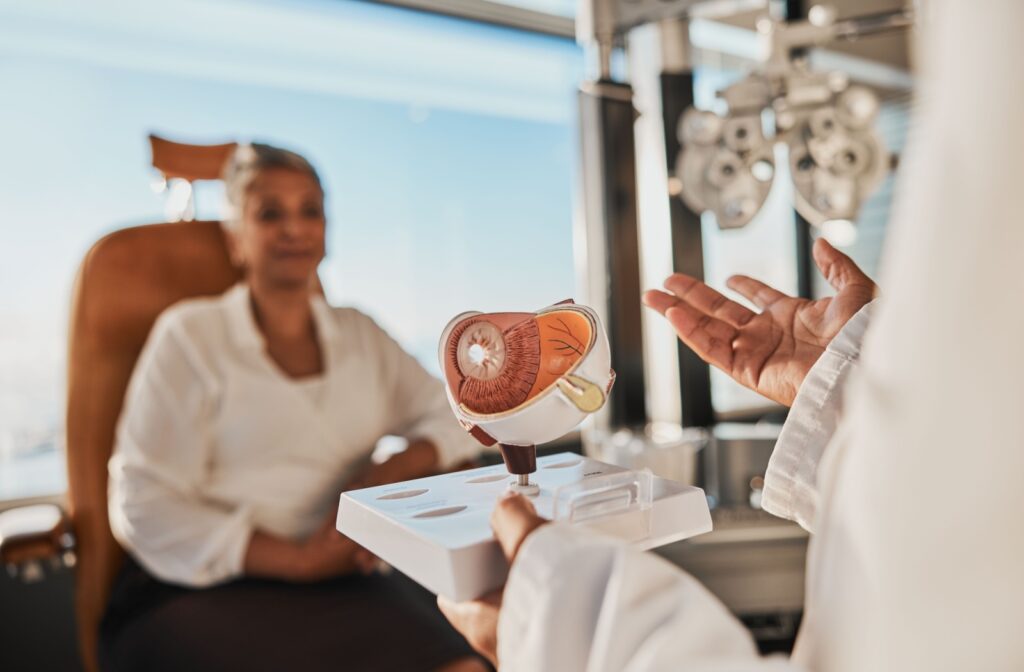Peripheral vision is something you likely don’t think about until it’s gone. It helps you see the world beyond your direct line of sight, making everyday activities like driving, walking, or even navigating a crowded room feel effortless. But when peripheral vision begins to fail, it can have a significant impact on your life.
Peripheral vision loss can stem from several causes, such as:
- Glaucoma
- Retinal detachment
- Diabetic retinopathy
- Tunnel vision
- Retinitis pigmentosa
- Eye injuries
If you experience any symptoms of peripheral vision, especially blurry or fluctuating vision, increasing eye floaters, or flashes, visit your optometrist, urgent care, or an emergency room immediately.
A Closer Look at Peripheral Vision
Take a quick look and process what you see right this moment.
Your central (straight ahead) vision is sharp and very detailed, whereas peripheral (side) vision falls outside of your direct line of sight. Though not as sharp, it’s still a valuable component of your overall visual field.
Peripheral vision helps with:
- Spatial awareness: It allows you to detect movement and objects without turning your head.
- Safety: It keeps you aware of your surroundings while driving, walking, or crossing streets.
- Depth and orientation: It helps you understand how objects relate to each other spatially.
Healthy peripheral vision requires several structures within the eye to work in harmony, including the retina (particularly the rod cells), optic nerve, and pathways leading to the brain. Damage to any of these areas (sudden or gradual) can lead to peripheral vision loss.
How quickly this loss happens depends on the underlying cause. Sudden loss can stem from conditions like retinal detachment or acute angle-closure glaucoma. Gradual peripheral vision loss can happen from glaucoma or diabetic retinopathy, as their progression continues.
What Leads to Peripheral Vision Loss?
Once vision is lost, we cannot restore it. The sooner we intervene with warning signs manifest, the better the outcome.
Early signs of peripheral vision loss can include:
- Difficulty spotting moving objects in your peripheral field
- Frequently bumping into objects or people
- Trouble driving, especially noticing cars or pedestrians coming from the sides
- A sensation of looking through a tunnel or narrow field of view
- Black or dark spots along the edges of vision
If you notice any of these symptoms, immediately visit your optometrist, urgent care, or emergency room.
Here are some of the most common causes of peripheral vision loss:
Glaucoma
Glaucoma is one of the leading causes of peripheral vision loss. It often begins unnoticed, damaging the optic nerve over time without clear symptoms.
One of glaucoma’s early signs (signaling its progression) may include tunnel vision, where peripheral vision shrinks, making it feel like you are looking through a narrow tube.
Without timely intervention, glaucoma can lead to complete blindness. Although glaucoma has no cure, we can effectively manage its progression, preserving your vision. The sooner we identify glaucoma, the better.
Retinal Detachment
Retinal detachment is a serious emergency. It happens when the retina separates from the underlying tissue, cutting off blood supply and causing vision loss.
Warning signs include:
- Flashes of light
- Increasing floaters
- A shadow or curtain over your field of vision.
If you think you have a retinal detachment, seek immediate care. With timely intervention, we can restore the retina to its proper placement and preserve your vision. Delaying treatment, however, can lead to permanent vision loss, which is never worth the gamble.
Diabetic Retinopathy
High blood sugar levels in people with diabetes can damage the retina’s delicate blood vessels, leading to diabetic retinopathy. As this condition progresses, peripheral vision can diminish, accompanied by blurry or fluctuating vision, floaters, or dark spots.
Annual diabetic eye exams can help detect diabetes-related changes in the eye, which we strongly advise for anyone with type 1 or type 2 diabetes. Managing diabetes can help lower the risk of diabetic retinopathy, but it doesn’t eliminate it entirely.
Tunnel Vision
Tunnel vision is a specific form of peripheral vision loss where the visual field narrows, leaving only central vision intact. It often results from glaucoma, retinal disorders, or neurological issues.
If you believe you’re experiencing tunnel vision, visit your optometrist right away.
Retinitis Pigmentosa
This is a rare genetic disorder that affects the retina and progressively causes tunnel vision.
People with retinitis pigmentosa may first notice difficulty seeing in dim light or the narrowing of their field of vision.
Eye Injuries
Trauma to the head or eyes can damage the optic nerve or retina, leading to partial or complete peripheral vision loss. This can occur immediately after an injury or develop over time.
Just as helmets protect your head while riding a bike or skiing down slopes, safety glasses shield your eyes from harmful debris or irritants (metal scraps, chemicals, etc.), especially if you work in a hazardous environment.

How to Protect Your Peripheral Vision
Peripheral vision loss is irreversible. The good news is that staying on top of your eye health can significantly reduce your risk or slow the progression of certain eye diseases.
Schedule Regular Eye Exams
Routine eye exams are your first line of defense. They can detect early signs of glaucoma, diabetic retinopathy, and other conditions before they damage your vision.
Manage Chronic Conditions
Not managing certain health conditions, like diabetes or high blood pressure, can lead to vision problems. Follow your doctor’s recommendations for medication, diet, and lifestyle changes to protect your overall eye health.
Adopt Healthy Habits
A few lifestyle changes can help keep your eyes in better shape:
- Eat a diet rich in eye-healthy nutrients like omega-3s, lutein, and vitamins C and E.
- Staying active helps improve blood flow, which benefits eye health.
- Avoid smoking, as it raises the risk of conditions like macular degeneration.
Address Symptoms Quickly
If you experience flashes of light, floaters, or a shadow in your vision, contact your eye doctor immediately. Conditions like retinal detachment or acute angle-closure glaucoma can progress quickly and require urgent treatment.
Taking Action for Healthy Vision
Your vision is priceless, and peripheral vision is a crucial part of how you experience the world. Its loss can significantly alter your independence and quality of life.
The good news? Early detection and proactive care can make all the difference.
If you’ve noticed any changes in your vision or simply want to keep your eyes healthy, connect with Seal Beach Eyes today. Book an appointment for your routine eye exam and preserve your vision.




